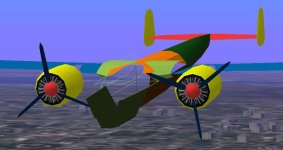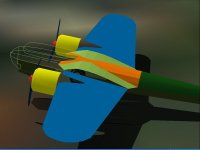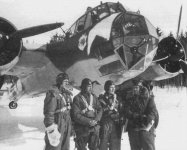aleatorylamp
Charter Member
Hello folks!
Well, after an inactive Christmas spell of overeating and generally doing as little as possible, I´ve decided to make a nice Dornier Do-17, which will hopefully be nicer than the stock AI version! Smilo also wants a nicer one, so all the more reason to do it!
Early Do-17 versions had 1000 Hp Bramo Fafnir 323 engines with single-speed superchargers, which gave only 900 Hp at S.L., but the Do-17z2 had the superior Bramo Fafnir 323P, with a 2-speed supercharger, making the full 1000 Hp were available at S.L.
Performance specifications of the real Dornier Do-17z2: (Note: Speed and power together are only given for S.L.)
> Sea level: 1000 Hp and 217 mph.
> 10200 ft: 1000 Hp.
> 13200 ft: 940 Hp.
> 16400 ft: 255 mph.
Work on the stock AI Do-17z2 Air file, which had far too much power and speed all round, so a lot of adjusting had to be done:
a) corrected cylinder displacement and RPM values
b) tweaked torque and friction graphs
c) considerably reduced Boost Gain value
d) adjusted drag values
Model Performance: (Maybe Ivan can give his always very much valued opinion here!)
> Sea level: 1003 Hp and 221 mph. (slightly fast)
> 10200 ft: 1071 Hp and 250 mph.
> 13200 ft: 940 Hp and 246 mph.
> 16400 ft: 813 Hp abd 244 mph. (a bit slow)
Generally seen, this performance looks quite acceptable, but I wonder what Ivan´s opinion would be! Only if you have time, Ivan, and are not too busy to answer or stressed out, of course!
Cheers and a Happy 2017 to all!
Aleatorylamp
Well, after an inactive Christmas spell of overeating and generally doing as little as possible, I´ve decided to make a nice Dornier Do-17, which will hopefully be nicer than the stock AI version! Smilo also wants a nicer one, so all the more reason to do it!
Early Do-17 versions had 1000 Hp Bramo Fafnir 323 engines with single-speed superchargers, which gave only 900 Hp at S.L., but the Do-17z2 had the superior Bramo Fafnir 323P, with a 2-speed supercharger, making the full 1000 Hp were available at S.L.
Performance specifications of the real Dornier Do-17z2: (Note: Speed and power together are only given for S.L.)
> Sea level: 1000 Hp and 217 mph.
> 10200 ft: 1000 Hp.
> 13200 ft: 940 Hp.
> 16400 ft: 255 mph.
Work on the stock AI Do-17z2 Air file, which had far too much power and speed all round, so a lot of adjusting had to be done:
a) corrected cylinder displacement and RPM values
b) tweaked torque and friction graphs
c) considerably reduced Boost Gain value
d) adjusted drag values
Model Performance: (Maybe Ivan can give his always very much valued opinion here!)
> Sea level: 1003 Hp and 221 mph. (slightly fast)
> 10200 ft: 1071 Hp and 250 mph.
> 13200 ft: 940 Hp and 246 mph.
> 16400 ft: 813 Hp abd 244 mph. (a bit slow)
Generally seen, this performance looks quite acceptable, but I wonder what Ivan´s opinion would be! Only if you have time, Ivan, and are not too busy to answer or stressed out, of course!
Cheers and a Happy 2017 to all!
Aleatorylamp





 .
.










